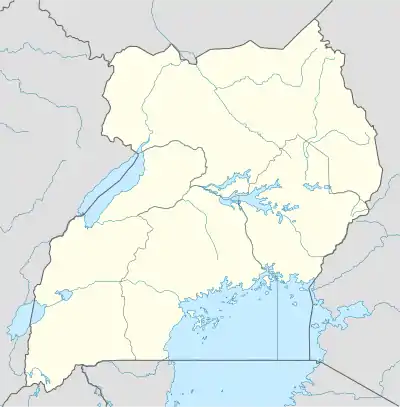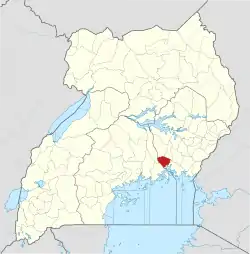Kiira Hydroelectric Power Station
Kiira Hydroelectric Power Station, is a hydroelectric power station in Uganda, with an installed capacity of 200 megawatts (270,000 hp).[1]
| Kiira Power Station | |
|---|---|
 Kiira Hydroelectric Power Station, marked with a red arrow. | |
 Map of Uganda showing the location of Kiira Power Station  Kiira Hydroelectric Power Station (Africa) .svg.png.webp) Kiira Hydroelectric Power Station (Earth) | |
| Official name | Kiira Hydropower Station |
| Country | Uganda |
| Location | Jinja |
| Coordinates | 00°27′01″N 33°11′08″E |
| Status | Operational |
| Construction began | 1993 |
| Opening date | 2003 |
| Owner(s) | Uganda Government |
| Operator(s) | Eskom Uganda Limited (Until 2022) |
| Dam and spillways | |
| Type of dam | Mass concrete |
| Impounds | Victoria Nile |
| Reservoir | |
| Normal elevation | 1,134 m (3,720 ft) |
| Operator(s) | Eskom Uganda Limited |
| Commission date | 2003 |
| Type | Run of the river |
| Turbines | 5 x 40 MW (Francis) |
| Installed capacity | 200 MW (270,000 hp) |
Location
The power station is located at Kimaka, a northern suburb of Jinja, in Jinja District, in the Eastern Region of Uganda, approximately 5.5 kilometres (3 mi) northwest of the central business district of the city of Jinja.[2]
Kiira Power Station operates next to the Nalubaale Power Station at the point where the River Nile pours out of Lake Victoria starting its 6,650 kilometres (4,130 mi)[3] journey to the Mediterranean Sea. The coordinates of Kiira Hydroelectric Power Station are: 0°27'01.0"N, 33°11'08.0"E (Latitude:0.450272; Longitude:33.185558).[4]
History
In 1993, work started on the Nalubaale Power Station extension project. The new project is a second powerhouse located about 1 kilometre (0.62 mi) northeast of the Nalubaale Power Station, which was built in 1954. A new canal was cut to bring water from Lake Victoria to the new powerhouse. Major construction was completed in 1999. The first power from two units out of the installed five units, came online in 2000.[5]
As of 2003, three of the five hydro power generators had been installed. Installation of the fifth and final turbine was completed in January 2007. Each unit at the extension has a capacity of 40 megawatts.[6] During official opening ceremonies in 2003, the extension was named the "Kiira Power Station". Design and project management of the extension project was by Acres International (now part of Hatch Ltd), Canada.[7]
Operations
In 2002, the government of Uganda, through the Uganda Electricity Generation Company, a 100 percent parastatal, awarded a 20-year operational, management, and maintenance concession to Eskom Uganda Limited, a subsidiary of Eskom, the South African energy company, to cover both Kiira Power Station and nearby Nalubaale Power Station. Eskom sells the electricity it generates to the Uganda Electricity Transmission Company Limited (UETCL), the authorized single buyer. UETCL resells the power to Umeme, the energy distributor.[8]
References
- Elias Biryabarema and George Obulutsa (9 May 2020). "Kenya and Uganda hit by power blackout, electricity back in most of Kenya" (Quoting Reuters). The Guardian Canada. Charlottetown, Prince Edward Island, Canada. Retrieved 2 August 2020.
- Google (2 August 2020). "Distance Between Downtown Jinja And Kiira Hydroelectric Power Station" (Map). Google Maps. Google. Retrieved 2 August 2020.
- https://www.britannica.com/place/Nile-River
- Google (2 August 2020). "Location of Kiira Hydroelectric Power Station" (Map). Google Maps. Google. Retrieved 2 August 2020.
- Africa Focus (21 February 2006). "East Africa: Dams and Lake Victoria" (Quoting cited sources in article). Africa Focus Organization. Retrieved 2 August 2020.
- Michael Wakabi (2 January 2007). "Uganda: Country to Test-Run Kiira Power Station". The East African. Nairobi. Retrieved 2 August 2020.
- UEGCL (15 July 2013). "Profile of Kiira Hydroelectric Power Station" (Archived from the original on 23 May 2015). Uganda Electricity Generation Company Limited (UEGCL). Retrieved 2 August 2020.
- Joseph Olanyo (5 August 2012). "ESKOM to Invest $20 Million On Nalubaale, Kiira Dams". The Observer (Uganda). Kampala. Retrieved 2 August 2020.

